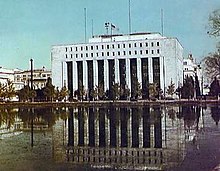This article has multiple issues. Please help improve it or discuss these issues on the talk page. (Learn how and when to remove these messages)
|

The Supreme Commander for the Allied Powers (Japanese: 連合国軍最高司令官, romanized: Rengōkokugun saikōshireikan), or SCAP, was the title held by General Douglas MacArthur during the United States-led Allied occupation of Japan following World War II. It issued SCAP Directives (alias SCAPIN, SCAP Index Number) to the Japanese government, aiming to suppress its "militaristic nationalism".[1] The position was created at the start of the occupation of Japan on August 14, 1945.[2] It was originally styled the Supreme Commander of the Allied Powers.[3]
In Japan, the position was generally referred to as GHQ (General Headquarters), as SCAP also referred to the offices of the occupation (which was officially referred by SCAP itself as General Headquarters, Supreme Commander for the Allied Powers (連合国軍最高司令官総司令部, Rengōkokugun saikōshireikan sōshireibu, abbreviated as GHQ–SCAP)), including a staff of several hundred US civil servants as well as military personnel. Some of these personnel effectively wrote a first draft of the Japanese Constitution, which the National Diet then ratified after a few amendments. Australian, British Empire, and New Zealand forces under SCAP were organized into a sub-command known as British Commonwealth Occupation Force.
These actions led MacArthur to be viewed as the new Imperial force in Japan by many Japanese political and civilian figures, even being considered to be the rebirth of the shōgun-style government[4]: 341 which Japan was ruled under until the start of the Meiji Restoration. American biographer William Manchester argues that without MacArthur's leadership, Japan would not have been able to make the move from an imperial, totalitarian state, to a democracy. At his appointment, MacArthur announced that he sought to "restore security, dignity and self-respect" to the Japanese people.[5]
MacArthur was also in charge of southern Korea from 1945 to 1948 due to the lack of clear orders or initiative from Washington, D.C. There was no plan or guideline given to MacArthur from the Joint Chiefs of Staff or the State Department on how to rule Korea, resulting in a tumultuous 3 year military occupation that led to the creation of the U.S.-friendly Republic of Korea in 1948. He ordered Lieutenant General John R. Hodge, who accepted the surrender of Japanese forces in southern Korea in September 1945, to govern that area on SCAP's behalf and report to him in Tokyo.[6][7]
- ^ S.C.A.P. (Jan 4, 1946). "Removal and Exclusion of Undesirable Personnel from Public Office". The National Diet Library (Japan). Retrieved 2019-02-20.
- ^ https://history.army.mil/books/wwii/MacArthur%20Reports/MacArthur%20V1%20Sup/ch3.htm
- ^ Hellegers, Dale M. (2002). We, the Japanese people. Stanford University Press. p. 360. ISBN 978-0-8047-8032-2.
- ^ Dower, John W. (1999). Embracing Defeat: Japan in the Wake of World War II. New York: W. W. Norton. ISBN 978-0-393-04686-1. OCLC 39143090.
- ^ Manchester, William (1978). American Caesar. Little, Brown and Company. p. 472. ISBN 0-316-54498-1.
- ^ "CHAPTER III: THE COMMAND STRUCTURE: AFPAC, FEC AND SCAP". history.army.mil. Retrieved 26 March 2021.[title missing]
- ^ "CHAPTER II:The House Divided". history.army.mil. Retrieved 26 March 2021.